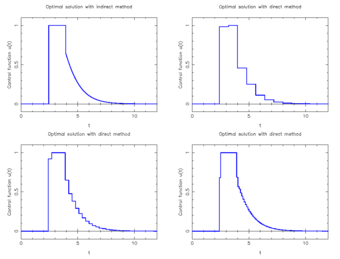Difference between revisions of "Lotka Volterra fishing problem"
| Line 45: | Line 45: | ||
<gallery> | <gallery> | ||
| − | Image: | + | Image:lotkaRelaxedControls.png| Optimal relaxed control determined by an indirect approach and by a direct approach on different control discretization grids. |
Image:lotkaindirektStates.png| Differential States and corresponding adjoint variables in the indirect approach. | Image:lotkaindirektStates.png| Differential States and corresponding adjoint variables in the indirect approach. | ||
</gallery> | </gallery> | ||
== Source Code == | == Source Code == | ||
| − | [[Image: | + | [[Image:lotkaRelaxedControls.png|thumb|340px|States]] |
=== C === | === C === | ||
Revision as of 23:48, 8 September 2008
| Lotka Volterra fishing problem | |
|---|---|
| State dimension: | 1 |
| Differential states: | 3 |
| Discrete control functions: | 1 |
| Interior point equalities: | 3 |
The Lotka Volterra fishing problem looks for an optimal fishing strategy to be performed on a fixed time horizon to bring the biomasses of both predator as prey fish to a prescribed steady state. The problem was set up as a small-scale benchmark problem. The well known Lotka Volterra equations for a predator-prey system have been augmented by an additional linear term, relating to fishing by man. The control can be regarded both in a relaxed, as in a discrete manner, corresponding to a part of the fleet, or the full fishing fleet.
It is thus an ODE model with a single integer control function. The interior point equality conditions fix the initial values of the differential states.
The optimal solution contains a singular arc, making the Lotka Volterra fishing problem an ideal candidate for benchmarking of algorithms.
Contents
[hide]Mathematical formulation
For ![t \in [t_0, t_f]](https://mintoc.de/images/math/5/5/8/55823791d9100bcb5461801aff4f6edd.png) almost everywhere the mixed-integer optimal control problem is given by
almost everywhere the mixed-integer optimal control problem is given by
![\begin{array}{llcl}
\displaystyle \min_{x, w} & x_2(t_f) \\[1.5ex]
\mbox{s.t.} & \dot{x}_0(t) & = & x_0(t) - x_0(t) x_1(t) - \; c_0 x_0(t) \; w(t), \\
& \dot{x}_1(t) & = & - x_1(t) + x_0(t) x_1(t) - \; c_1 x_1(t) \; w(t), \\
& \dot{x}_2(t) & = & (x_0(t) - 1)^2 + (x_1(t) - 1)^2, \\[1.5ex]
& x(0) &=& x_0, \\
& w(t) &\in& \{0, 1\}.
\end{array}](https://mintoc.de/images/math/e/9/3/e93178d5bd1af2eb33e434a69e6883c7.png)
Initial values and parameters
These fixed values are used within the model.
![\begin{array}{rcl}
[t_0, t_f] &=& [0, 12],\\
(c_0, c_1) &=& (0.4, 0.2),\\
x_0 &=& (0.5, 0.7, 0)^T.
\end{array}](https://mintoc.de/images/math/a/8/b/a8b6192b6bad3998ff2728a6397819b5.png)
Reference Solutions
If the problem is relaxed, i.e., we demand ![w(t) \in [0, 1]](https://mintoc.de/images/math/d/8/b/d8b966d03f416aecd2f9103830904e64.png) instead of
instead of  , the optimal solution can be determined by means of Pontryagins maximum principle. The optimal solution contains a singular arc, as can be seen in the plot of the optimal control. The two differential states and corresponding adjoint variables in the indirect approach are also displayed.
, the optimal solution can be determined by means of Pontryagins maximum principle. The optimal solution contains a singular arc, as can be seen in the plot of the optimal control. The two differential states and corresponding adjoint variables in the indirect approach are also displayed.
Source Code
C
The differential equations in C code:
/* steady state with u == 0 */ double ref0 = 1, ref1 = 1; /* Biomass of prey */ rhs[0] = xd[0] - xd[0]*xd[1] - p[0]*u[0]*xd[0]; /* Biomass of predator */ rhs[1] = - xd[1] + xd[0]*xd[1] - p[1]*u[0]*xd[1]; /* Deviation from reference trajectory */ rhs[2] = (xd[0]-ref0)*(xd[0]-ref0) + (xd[1]-ref1)*(xd[1]-ref1);
AMPL
The model in AMPL code with a collocation method. We need a model file lotka_ampl.mod,
# ---------------------------------------------------------------- # Lotka Volterra fishing problem with collocation (explicit Euler) # (c) Sebastian Sager # ---------------------------------------------------------------- param T > 0; param nt > 0; param c1 > 0; param c2 > 0; param ref1 > 0; param ref2 > 0; param dt := T / (nt-1); set I:= 0..nt; var x {I, 1..2} >= 0; var w {I} >= 0, <= 1 binary; minimize Deviation: 0.5 * dt * ( (x[0,1] - ref1)*(x[0,1] - ref1) + (x[0,2] - ref2)*(x[0,2] - ref2) ) + 0.5 * dt * ( (x[nt,1] - ref1)*(x[nt,1] - ref1) + (x[nt,2] - ref2)*(x[nt,2] - ref2) ) + dt * sum {i in I diff {0,nt} } ( (x[i,1] - ref1)*(x[i,1] - ref1) + (x[i,2] - ref2)*(x[i,2] - ref2) ) ; subj to ODE_DISC_1 {i in I diff {0}}: x[i,1] = x[i-1,1] + dt * ( x[i-1,1] - x[i-1,1]*x[i-1,2] - x[i-1,1]*c1*w[i-1] ); subj to ODE_DISC_2 {i in I diff {0}}: x[i,2] = x[i-1,2] + dt * ( - x[i-1,2] + x[i-1,1]*x[i-1,2] - x[i-1,2]*c2*w[i-1] );
a data file lotka_ampl.dat,
# ------------------------------------ # Data: Lotka Volterra fishing problem # ------------------------------------ # Algorithmic parameters param nt := 100; # Problem parameters param T := 12.0; param c1 := 0.4; param c2 := 0.2; param ref1 := 1.0; param ref2 := 1.0; # Initial values differential states let x[0,1] := 0.5; let x[0,2] := 0.7; fix x[0,1]; fix x[0,2]; # Initial values control let {i in I} w[i] := 0.0; fix w[nt]; param mysum;
and a running script lotka_ampl.run,
# ---------------------------------------------------- # Solve Lotka Volterra fishing problem via collocation # ---------------------------------------------------- model ampl_lotka.mod; data ampl_lotka.dat; option solver bonmin; solve;
Miscellaneous and Further Reading
The Lotka Volterra fishing problem was introduced by Sebastian Sager in a proceedings paper <bibref>Sager2006</bibref> and revisited in his PhD thesis <bibref>Sager2005</bibref>. These are also the references to look for more details.
References
<bibreferences/>


